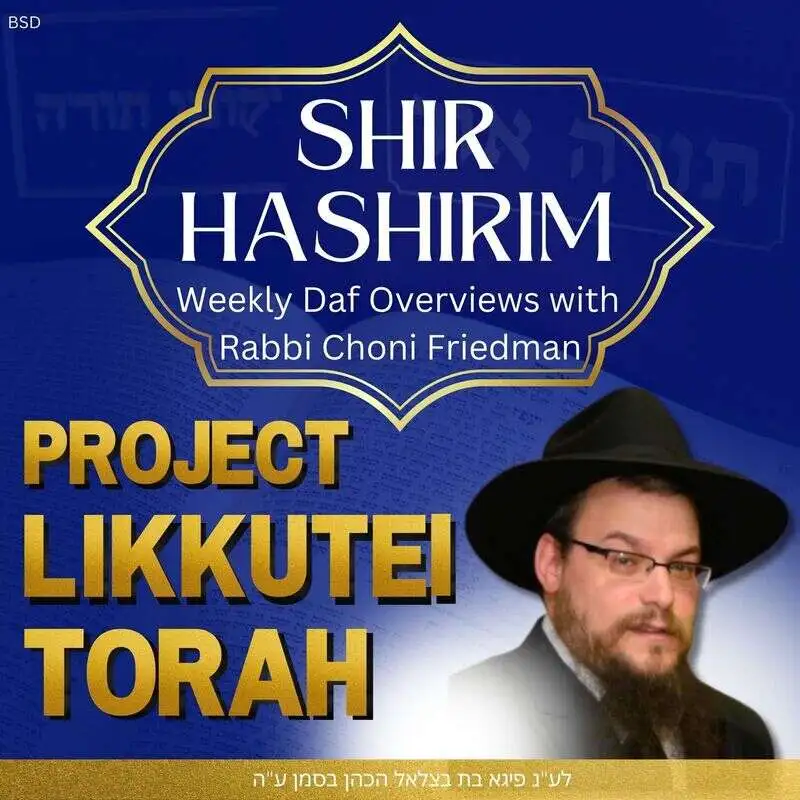Likkutei Torah Shir Hashirim Daf 1
Download MP3We are excited to launch a Shir Hashirim Weekly Daf Cycle to be learned in addition to the Daily Daf of Torah Ohr in order to finish the entire Torah Ohr / Likkutei Torah in one year!
“Shir Hashirim asher l’Shlomo, yashekeini m’nishikas pihu, ki tovim dodecha m’yayin”
- Hashem is called Chosson, and BN”Y (collectively and individually) are called Kallah.
- Chosson implies hashpaah: Hashem gives Himself to BN”Y through Torah.
- Kalah implies 1) nullification, and 2) desire.
- In Krias Shemah, there are two types of MS”N. The first is related to “Echad”, and the second to “B’chol nafshecha”.
Q1- what are these two types of MS”N?
Q2- what is the difference between the two?
Q3- if the first one implies complete bittul, how does one then have the second one, which is a result of realizing that Hashem is the source of one’s life?
- A1/2/3:
- The first kind of MS”N occurs when one contemplates the fact that from the perspective of Ein Sof, nothing exists outside of Hashem (Echad). From this perspective, Chillul Hashem= identifying something as being separate/distinct from Hashem, including one’s own self. One’s desires are completely nullified, and all that is left is one’s desire to be enveloped in Ein Sof (mi li bashomayim). (This is the perspective of YICH”I)
- The second type of MS”N comes when one is aware of one’s self and the world as separate from Hashem, but desires to come close to Hashem.
- In between these two types of MS”N (and the source of the latter) is Boruch shem, which represents the way Hashem is invested in creating the world, and yet at the same time, the world is not really separate from Elokus (This is the perspective of YICH”T)
- Through this, we can go from the level of echad to the level of bchol nafshecha.
- The two types of Kallah correspond to two types of Chosson.
- The first type of Chosson (we will discuss the second type next week)
We need to understand the idea of “shmo hagadol”, “hu ushmo bilvad”:
- Hakadosh Baruch Hu= Atzmus. “yoshev v’osek b’Torah”= the way Atzmus invests itself in Torah. At the deepest level, Shmo=Yicholes. This is shmo Hagadol, which is infinite.
- Creation only comes from a progression of SHSH”T+Tzimtzumim (which allows for there not to be any change in Hashem, and for the world to be limited).
- There is the way Torah exists in Atzilut (Oraysa m’Chochma…) and there is the higher level of Torah (Taamei Torah) which is beyond Atzilus and is rooted in Taanug (Kesser). This is called the “song of Torah” (raninah d’oraisah) and is expressed in the musical notation of Torah, which is higher than the letters of Torah.
- “Shirah”= the way each level of SD”H ascends to the level above it, in a way of RTV”S, oleh v’yored. This is the level of Kalah. Through this, we reach the raninah d’Oraysa=Shmo Hagadol=Oneg HaElyon, Chosson.
- “Asher l’Shlomo”: Shalom= peace, unity between Hashem and the world. This occurs through Torah/Taanug. “Yashkeini m’nishikas pihu”: Hashem’s investment of Himself into (Taamei) Torah. Just as neshikin implies an expression of love that is beyond language and can only be expressed in a physical act, so too, Torah represents the deepest expression of Hashem’s love towards BN”Y, and His desire to connect to them through His confining (Tzimztum) of Himself in Torah, Shmo Hagadol.
Concepts
- Hashem= Chosson, BN”Y= Kallah
- Two types of MS”N= YICH”I/YICH”T
- Torah is the deepest expression of Hashem’s des
Support the show (https://www.paypal.com/donate?hosted_button_id=SVCNKGSMCEANE)
★ Support this podcast ★

